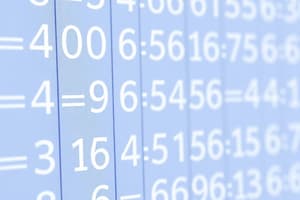Podcast
Questions and Answers
What is the result of adding two negative numbers, such as -3 and -4?
What is the result of adding two negative numbers, such as -3 and -4?
- -1
- 1
- -7 (correct)
- 0
When adding a negative number and a positive number, what is the correct process?
When adding a negative number and a positive number, what is the correct process?
- Add the numbers normally and keep the positive sign.
- Subtract the smaller absolute value from the larger and keep the sign of the larger. (correct)
- Ignore the signs and subtract the larger from the smaller.
- Add their absolute values.
What is the result of multiplying two negative numbers?
What is the result of multiplying two negative numbers?
- Negative
- Zero
- Positive (correct)
- Undefined
Which of the following is true regarding prime numbers?
Which of the following is true regarding prime numbers?
What does LCM stand for and what does it refer to?
What does LCM stand for and what does it refer to?
What is the outcome when applying the rules of HCF to the numbers 12 and 15?
What is the outcome when applying the rules of HCF to the numbers 12 and 15?
Which of the following statements accurately describes the concept of squares and cubes?
Which of the following statements accurately describes the concept of squares and cubes?
Which of the following is an integer?
Which of the following is an integer?
Which of the following statements accurately describes composite numbers?
Which of the following statements accurately describes composite numbers?
What is the correct result of the expression $3 + 2 \times (4^2 - 2)$ following the order of operations?
What is the correct result of the expression $3 + 2 \times (4^2 - 2)$ following the order of operations?
Which of the following examples correctly illustrates the rule for adding a positive and a negative number?
Which of the following examples correctly illustrates the rule for adding a positive and a negative number?
What is the highest common factor (HCF) of 12 and 18?
What is the highest common factor (HCF) of 12 and 18?
Which of the following represents a prime number?
Which of the following represents a prime number?
What will be the outcome of multiplying two negative numbers?
What will be the outcome of multiplying two negative numbers?
Which expression shows the correct order of operations applied to solve $2 + 3 \times 4 - 5$?
Which expression shows the correct order of operations applied to solve $2 + 3 \times 4 - 5$?
What is the square of 5?
What is the square of 5?
Which of the following expressions represents the cube of 3?
Which of the following expressions represents the cube of 3?
Which of the following is NOT a rule for adding negative numbers?
Which of the following is NOT a rule for adding negative numbers?
Flashcards
What are integers?
What are integers?
Integers are whole numbers, including positive numbers, negative numbers, and zero.
Adding two negative numbers
Adding two negative numbers
Adding two negative numbers results in a more negative sum. For example: -3 + (-4) = -7
Adding a negative and a positive number
Adding a negative and a positive number
Adding a negative and a positive number involves subtracting the smaller absolute value from the larger and keeping the sign of the larger number. For example: -5 + 3 = -2.
Multiplying two negative numbers
Multiplying two negative numbers
Signup and view all the flashcards
What is a square?
What is a square?
Signup and view all the flashcards
What is a cube?
What is a cube?
Signup and view all the flashcards
What is the LCM?
What is the LCM?
Signup and view all the flashcards
What is the HCF?
What is the HCF?
Signup and view all the flashcards
Composite Number
Composite Number
Signup and view all the flashcards
Order of Operations
Order of Operations
Signup and view all the flashcards
Powers (Indices)
Powers (Indices)
Signup and view all the flashcards
Least Common Multiple (LCM)
Least Common Multiple (LCM)
Signup and view all the flashcards
Highest Common Factor (HCF)
Highest Common Factor (HCF)
Signup and view all the flashcards
Prime Number
Prime Number
Signup and view all the flashcards
Adding Negative Numbers
Adding Negative Numbers
Signup and view all the flashcards
Adding Positive and Negative Numbers
Adding Positive and Negative Numbers
Signup and view all the flashcards
Multiplying Negative Numbers
Multiplying Negative Numbers
Signup and view all the flashcards
Multiplying Positive and Negative Numbers
Multiplying Positive and Negative Numbers
Signup and view all the flashcards
Study Notes
Negative Numbers
- Integers include positive whole numbers, zero, and their negative counterparts.
- Negative numbers are less than zero.
- Adding two negative numbers results in a more negative number. Example: -3 + (-4) = -7
- Adding a positive and a negative number involves subtracting the smaller absolute value from the larger, and using the sign of the larger number. Example: 5 + (-8) = -3.
- Multiplying two negative numbers results in a positive number. Example: -2 x -3 = 6
- Multiplying a negative and a positive number results in a negative number. Example: -2 x 3 = -6
Squares and Cubes
- Squaring a number means multiplying it by itself. Example: 3² = 3 x 3 = 9
- Cubing a number means multiplying it by itself three times. Example: 2³ = 2 x 2 x 2 = 8
LCM, HCF, and Primes
- Lowest Common Multiple (LCM) is the smallest multiple shared by two numbers. Example: LCM of 4 and 6 is 12.
- Highest Common Factor (HCF) is the largest factor shared by two or more numbers. Example: HCF of 12 and 18 is 6.
- Prime numbers have only two factors: 1 and the number itself. Examples of prime numbers: 2, 3, 5, 7, 11.
- Composite numbers have more than two factors. Examples of composite numbers: 4, 6
Order of Operations (BIDMAS/PEMDAS)
- Brackets/parentheses: Solve expressions inside the brackets first.
- Indices/Exponents: Calculate the exponents next.
- Division/Multiplication: Perform multiplication and division from left to right.
- Addition/Subtraction: Perform addition and subtraction from left to right.
- Example: 3 + 2 x (4² - 2) = 3 + 2 x (16 - 2) = 3 + 2 x 14 = 3 + 28 = 31
Studying That Suits You
Use AI to generate personalized quizzes and flashcards to suit your learning preferences.




